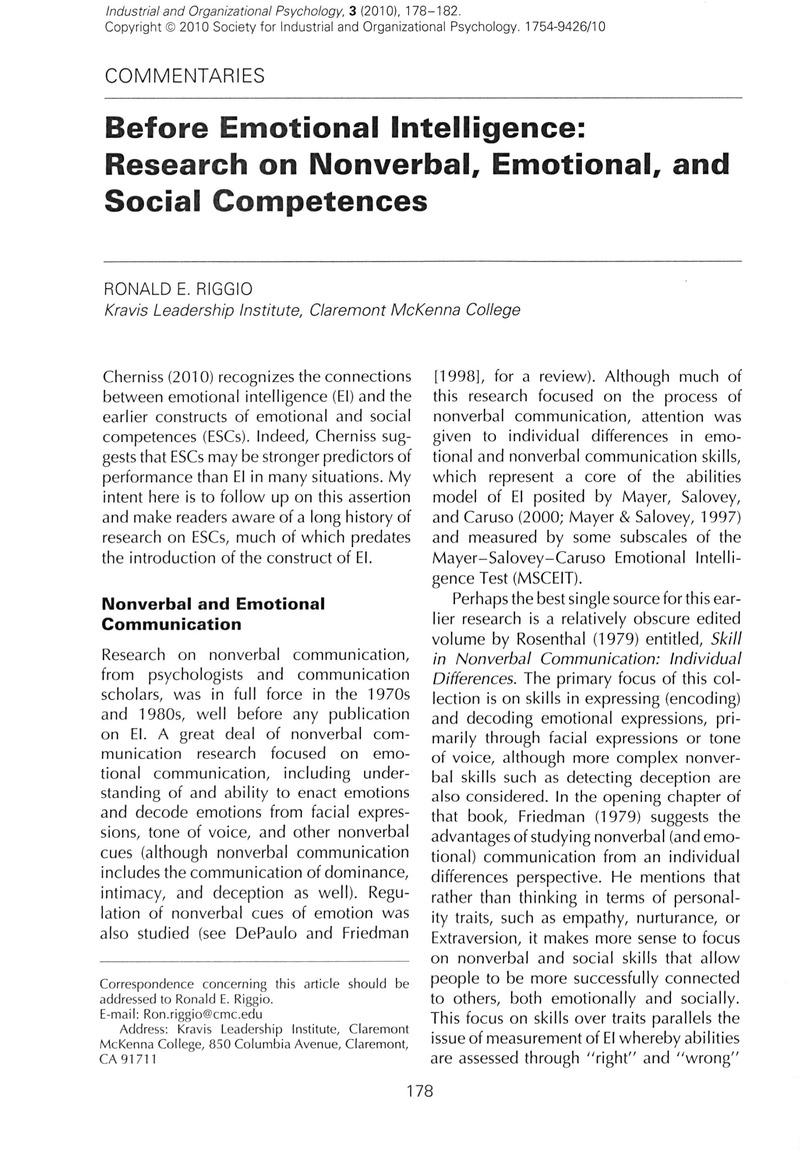Crossref Citations
This article has been cited by the following publications. This list is generated based on data provided by Crossref.
Chavez, Mark
and
Yi, Liu Lin
2010.
Cinematics and Narratives: An Exploitation of Real-Time Animation.
p.
287.
Cherniss, Cary
2010.
Emotional Intelligence: New Insights and Further Clarifications.
Industrial and Organizational Psychology,
Vol. 3,
Issue. 2,
p.
183.
Boyatzis, Richard E.
Good, Darren
and
Massa, Raymond
2012.
Emotional, Social, and Cognitive Intelligence and Personality as Predictors of Sales Leadership Performance.
Journal of Leadership & Organizational Studies,
Vol. 19,
Issue. 2,
p.
191.
Emmerling, Robert
Emmerling, Robert J.
and
Boyatzis, Richard E.
2012.
Emotional and social intelligence competencies: cross cultural implications.
Cross Cultural Management: An International Journal,
Vol. 19,
Issue. 1,
p.
4.
Ryan, Ann Marie
and
Ployhart, Robert E.
2014.
A Century of Selection.
Annual Review of Psychology,
Vol. 65,
Issue. 1,
p.
693.
Lanciano, Tiziana
and
Curci, Antonietta
2015.
Does Emotions Communication Ability Affect Psychological Well-Being? A Study with the Mayer–Salovey–Caruso Emotional Intelligence Test (MSCEIT) v2.0.
Health Communication,
Vol. 30,
Issue. 11,
p.
1112.
Cherniss, C.
Roche, C.
and
Barbarasch, B.
2016.
Encyclopedia of Mental Health.
p.
108.
Kumar Singh, Thomas F. Burgess and John Heap, Sanjay
Almatrooshi, Bashaer
Singh, Sanjay Kumar
and
Farouk, Sherine
2016.
Determinants of organizational performance: a proposed framework.
International Journal of Productivity and Performance Management,
Vol. 65,
Issue. 6,
p.
844.
Passarelli, Angela M.
Boyatzis, Richard E.
and
Wei, Hongguo
2018.
Assessing Leader Development: Lessons From a Historical Review of MBA Outcomes.
Journal of Management Education,
Vol. 42,
Issue. 1,
p.
55.
Vydrová, Janka
2018.
CORE COMPETENCIES OF THE HEALTHCARE ORGANIZATION WORKERS NEEDED TO PERFORM THEIR WORK WITHIN THE SOCIAL MATURITY PILLAR.
Acta academica karviniensia,
Vol. 18,
Issue. 4,
p.
89.
Segrin, Chris
and
Flora, Jeanne
2019.
Fostering social and emotional intelligence: What are the best current strategies in parenting?.
Social and Personality Psychology Compass,
Vol. 13,
Issue. 3,
Bjekić, Radmila
Rodić, Marijana
Aleksić, Marko
and
Gašić, Dimitrije
2021.
Relationship between social competences of manager and leadership outcomes.
Ekonomika,
Vol. 67,
Issue. 2,
p.
47.
Fernandes, Ana
Proença, Teresa
Ferreira, Marisa R.
and
Paço, Arminda
2021.
Does youth civic engagement enhance social and academic performance?.
International Review on Public and Nonprofit Marketing,
Vol. 18,
Issue. 2,
p.
273.
Riggio, Ronald E.
and
Crawley, Alan
2022.
Nonverbal Communication in Close Relationships.
p.
341.
Rivera-Mata, Juan
2022.
Study Abroad Develops Cultural Intelligence for International Business Effectiveness, Special Relevance for PELL Students.
Frontiers: The Interdisciplinary Journal of Study Abroad,
Vol. 34,
Issue. 4,
p.
144.
Wild, Marcus G.
Cutler, Rebecca A.
and
Bachorowski, Jo-Anne
2023.
Quantifying social performance: A review with implications for further work.
Frontiers in Psychology,
Vol. 14,
Issue. ,
Johnsen, Jan‐Are K.
Borit, Melania
and
Stangvaltaite‐Mouhat, Lina
2023.
Using storytelling in undergraduate dental education: Students' experiences of emotional competence training.
European Journal of Dental Education,
Vol. 27,
Issue. 4,
p.
793.



